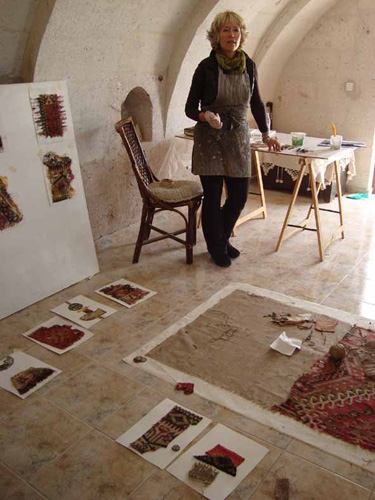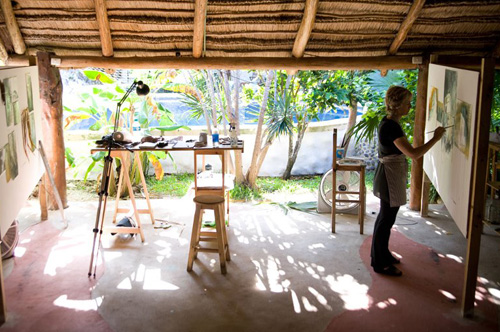by Carolyn Edlund
Amy Guion Clay is an artist, traveler and teacher who often lives as an artist in residence around the world. She offers tips for others who are interested in an artist residency.

Artist Amy Guion Clay participated in a residency in Turkey
“I’m obsessed with art and travel,” says Clay. “When I discovered the global network of artist residencies, I found the perfect form for my creative wanderings, as they combined my great loves of art, travel and community of creative people.”
Since 2009, Clay has been to 20 residencies in 14 different countries around the world and counting. She’s stayed in such places as Turkey, India, Iceland and New Zealand. I spoke with her about the topic, asking her to share insights for other artists interested in artist residency process and experience.
AS: How would you define an artist residency, and how can they differ?
AGC: Artist residencies are dedicated places around the world that offer artists of all disciplines a place to focus on their creative projects away from their usual lives. They differ in so many ways – in fact no two are alike! Most of them offer accommodations and a studio or work space. They might be private or shared, and the costs can vary widely. Some may charge a fee, others might be free, and some will even offer a stipend. As you can imagine, those are much more competitive!
The average residency lasts a month, but some will be shorter, and others can last a year or more. And of course they vary so much by location – the culture, language, landscape, city or urban areas, etc.

Working at an artist residency in Ondarte Palapa in Akumal, Mexico.
AS: How can artists find out about residency opportunities?
AGC: Research is critical. Google is the obvious place to start. But there are thousands of residencies, so I suggest narrowing down your search with a database website like ResArtis. A warning though – it’s a rabbit hole of possibilities, and can be hugely time consuming. I developed an online course about residencies, which takes you through the research and application process step by step to help save time and money, and eliminate some of the overwhelming aspects of the research.
AS: What are your recommendations for successfully applying?
AGC: First of all, define why you are doing a residency vs. just going on a vacation to Mexico. That will help you decide where you want to go and how that place might relate to a project you want to do there. For example, maybe your thing is Chinese kitsch, or traditional calligraphy, so finding a residency in Beijing might be of interest. Or if you want peace and quiet in a natural environment, you can research the U.S. National Park Residencies.
Make sure you read all the FAQ’s about each residency, because they all have different criteria. Some might want young emerging artists, or their focus might be environmental or humanitarian issues. Each one will charge a fee, so don’t waste time and money applying to ones that aren’t relevant to you.
In my course I go over the details of the application process and how to craft a compelling project. This is the beating heart of your application, and it’s important to craft it in a way that is authentic and inspiring.

Artist Residency Group in Portgal
AS: What can an artist expect to experience in a residency?
AGC: I could spend hours telling you stories about the different kind of residencies I’ve experienced! I’ve been with a large group of rowdy artists in an old farmhouse in northern Spain, and been the only artist in rural New Zealand. I’ve lived above a noisy Biergarten with a group of young artists in East Berlin, and worked in cave dwellings in a tiny traditional village in central Turkey.
But typically, know that this lifestyle is often communal living with all it’s pros and cons. You will almost always have your own room, but might share a house with others. Or you could have your own apartment with a kitchen and only meet the other artists for weekly shared meals. Or not at all. This is why the research is so important.
There are the rare disasters – like when I arrived at a residency in Slovenia, and the studio had an “art installation” in the center that was a scorpion’s nest, and I was not to disturb it! That was just one thing that was very wrong about that place, so I left after four days (it was supposed to be a month), and I never got a refund for the 800 euros I had paid upfront. The upside was that I visited Venice during the Biennale for a few days on my way to Slovenia, which was hugely inspirational! (By the way, that residency doesn’t exist anymore, which is not surprising.)
I wrote a book about my first two years of doing residencies called The Far Shores of Being, which can be downloaded for free on my website. This will give some further insight into some of the different places I’ve experienced.
AS: If an artist is considering a residency, what do you recommend that they keep in mind?
AGC: If you have been accepted, make sure to prepare well, with clothing and art. Often you won’t be able to easily stock up on supplies if you are in a remote location. And most importantly, try to be open, flexible and tolerant. Things might not be as you expected, but often they can be even better. See it as an adventure as much as a place to focus on your work, because no doubt it will be!
In my course on artist residencies, I cover most everything from start to finish. I include lots of photos to illustrate the various places I’ve been and experiences I’ve had. I also show lots of images of how I interpreted my environment in the work that I did at each residency, which might spark some ideas for project proposals.
So buckle up and enjoy the wild ride of being an artist in residence around the world!

This is so inspirational, I love this concept of the travelling artist. I was searching for this type of a lifestyle and have finally found the solution. Thank you so much for your insights!
Hi Valentina,
Thanks so much for your comment. It’s an addictive lifestyle and I’m glad that you are inspired to combine art and travel! I write about this regularly on my blog at http://www.amyclay.com/blog/ if you want to know more about living this life.
Happy art/traveling!
Amy Clay